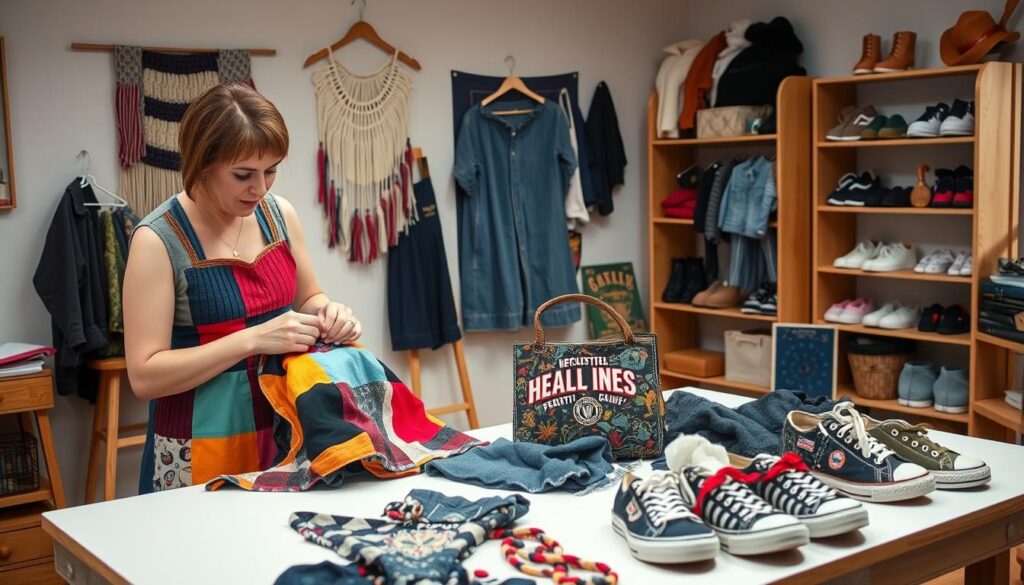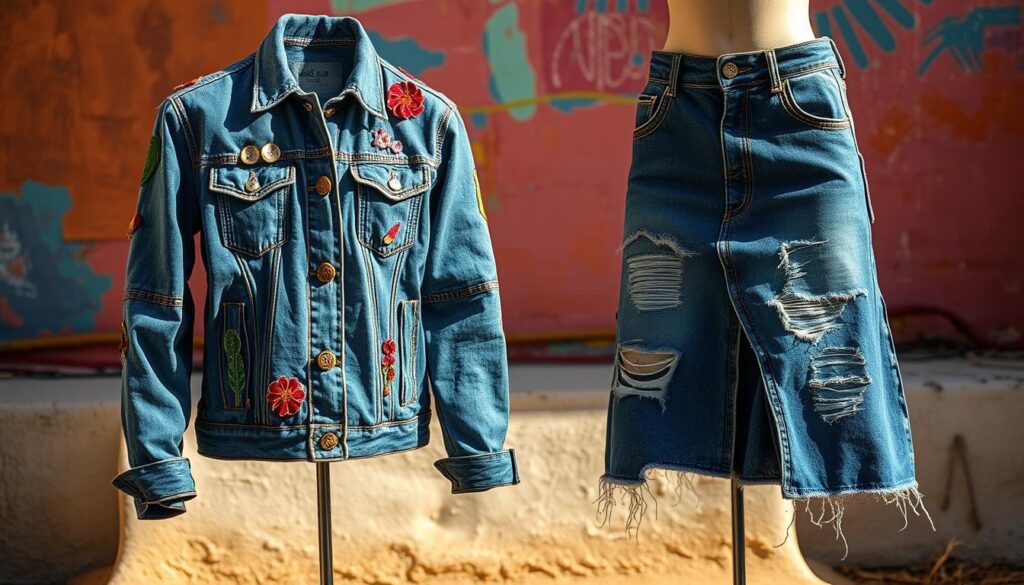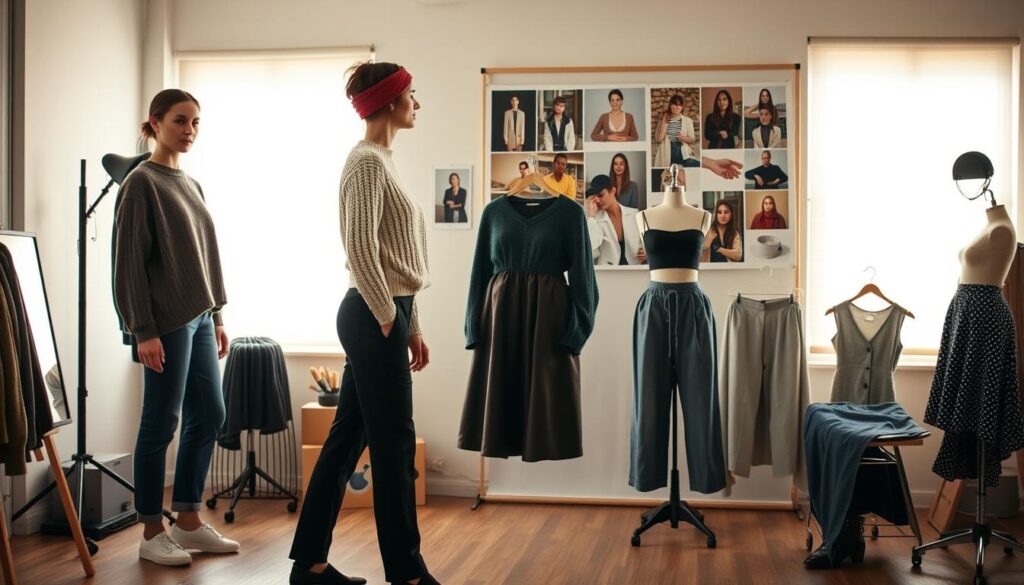Upcycling old clothes is a creative way to breathe new life into your wardrobe. It’s all about sustainable fashion. By using clever hacks, you can turn old clothes into unique pieces. This not only saves money but also helps the environment.

Upcycling old clothes is a smart move for the planet. It means you don’t need to buy as much new, resource-heavy clothing. It’s also budget-friendly, making it a great way to update your style without spending a lot.
Key Takeaways
- Upcycling old clothes reduces waste and supports sustainable fashion
- Clothing transformation can be a cost-effective way to refresh your wardrobe
- Upcycling old clothes hacks can help you create unique, personalized pieces
- Sustainable fashion approaches can reduce the environmental impact of the fashion industry
- Upcycling old clothes can be a fun and creative way to express your personal style
Why Upcycling Old Clothes Makes Sense
Upcycling old clothes is a smart way to cut down on waste. It lets you make one-of-a-kind items that show off your style. This approach to DIY fashion is both good for the planet and your wallet. It’s a simple way to make your clothes last longer and reduce harm to the environment.
Some of the benefits of upcycling old clothes include:
- Reducing waste and pollution
- Saving money by extending the life of your clothes
- Creating unique and personalized pieces that reflect your style
The fashion industry is a big polluter, with fast fashion adding to the problem. By upcycling, you help lessen this impact.
Choosing DIY fashion and eco-friendly style is good for the planet. It’s also a fun way to show off your creativity. With a bit of imagination and basic sewing, you can make old clothes into something new and cool. So, why not try upcycling and see what you can create?
Essential Tools and Materials for Clothes Upcycling
To start with clothing recycling and creative fashion, you need the right tools and materials. You’ll need basic sewing tools like scissors, needles, and threads. Also, a sewing machine, fabric glue, and crafting supplies like ribbons, buttons, and embroidery floss are important.
Here’s a list of essential tools and materials for upcycling:
- Scissors
- Needles and threads
- Sewing machine
- Fabric glue
- Ribbons and buttons
- Embroidery floss
Having these tools and materials makes upcycling easier and more fun. You can find them at craft stores or online. Choose materials that fit your project and skill level. With the right tools and materials, you can make unique and stylish pieces through clothing recycling and show your creative fashion sense.
Preparing Your Clothes for Transformation
To make your fashion upcycling project a success, you need to prepare your clothes first. This step is key to getting the look you want. When you’re on a budget, getting ready right can really help. Start by collecting your materials and sorting your clothes to see which ones can be upcycled.
Look closely at each item before you start. Check for stains, tears, and other damage. This is also a good time to think about the fabric type, color, and texture. These details will help guide your design choices. By preparing well, you can make unique and stylish clothes that show off your personal style.
Some important things to think about when getting your clothes ready include:
- Cleaning and washing the items to remove any dirt or stains
- Assessing the condition of the fabric and identifying any areas that may need repair
- Planning your design, taking into account the fabric type, color, and texture
By following these steps and being careful with your materials, you can make amazing and eco-friendly clothes. These will show off your upcycling skills and style without spending a lot.
Quick No-Sew Upcycling Old Clothes Hacks
Upcycling old clothes is a fantastic way to cut down on waste and make unique items for your closet. You don’t need to sew to start. There are many quick, no-sew hacks to turn old clothes into something new and fun. You can use fabric glue and tape to make accessories like scarves and hats.
If you love DIY fashion, upcycling is a great way to be creative. You can make a reusable bag from an old t-shirt or turn jeans into a skirt. The idea is to think creatively and find new uses for your old clothes.
Some popular no-sew upcycling methods include:
- Using fabric glue to attach embellishments or patches to your clothes
- Utilizing tape to create unique designs or patterns
- Transforming old clothes into accessories like scarves, hats, or bags
These no-sew methods are great for beginners or anyone who wants to upcycle without sewing. With a bit of creativity, you can make something truly special from your old clothes. So, why not try it and see what you can make with upcycling hacks and DIY fashion?
Transform T-Shirts Into Trendy Pieces
Upcycling old t-shirts is a great way to refresh your wardrobe. It’s also a way to follow an eco-friendly style. With a bit of creativity, you can make your old t-shirts into unique and trendy items. This process is fun and rewarding, letting you create something new from old items.
There are many ways to upcycle t-shirts. You can make crop tops, bags, and totes from them. You can also craft braided accessories like headbands and belts. These projects not only reduce waste but also let you show off your style.
- Crop top variations: Cut off the bottom of an old t-shirt to create a trendy crop top that can be paired with high-waisted pants or a skirt.
- T-shirt bags and totes: Turn old t-shirts into reusable bags that are perfect for grocery shopping or carrying your daily essentials.
- Braided accessories: Use old t-shirts to create braided headbands, belts, or other accessories that add a unique touch to your outfit.
These projects are easy to make and promote an eco-friendly style. Upcycling old t-shirts reduces waste and lets you create something new and exciting. It makes the process of transforming clothes a fun and rewarding experience.
Denim Transformation Projects
Denim is a favorite fabric for fashion upcycling. It can be turned into many items, like jackets from old jeans. This way, we can make unique, stylish pieces and cut down on waste, supporting sustainable fashion.
With a bit of creativity, you can give new life to your old denim clothes. Here are some ideas:
- Upcycling old jeans into shorts or skirts
- Transforming denim jackets into bags or accessories
- Creating denim quilts or patchwork blankets
These projects help reduce waste and support sustainable fashion. By upcycling denim, we lessen the need for new clothes. This helps the environment and fights the fashion industry’s big impact.

By choosing fashion upcycling and sustainable fashion, we help the planet. We also show off our personal style. So, let’s get creative and turn old denim into something new and cool!
Adding Modern Elements to Vintage Pieces
When it comes to clothing recycling, giving old clothes a new life is fun and creative. It helps reduce waste and lets you create unique items. By adding modern touches to vintage pieces, you can make them cool again. This shows off your personal style in a unique way.
This approach to creative fashion is good for the environment. It also lets you express yourself through your clothes.
To start, think about these ways to modernize your vintage finds:
- Techniques like embroidery, appliqué, and patching can add a modern touch.
- Modern color blocking can make bold, eye-catching designs that update old items.
- Pattern mixing can give vintage pieces a modern twist by combining different textures and patterns.
By using these methods, you can give old clothes a new life. They can become part of your modern wardrobe. Remember, the key is to have fun and be creative. Don’t be afraid to try new things – it’s all part of the creative fashion journey.
Combining Multiple Garments
Upcycling old clothes can get really creative by mixing different pieces. This way, you can try out new fabrics, textures, and styles. It lets you make something special that shows off your unique taste.
Think about turning old shirts into dresses or mixing jeans and jackets for a cool jumpsuit. You can even use many scarves to make a colorful skirt. The trick is to mix things in a way that looks good together. DIY fashion fans can find lots of ideas online, with step-by-step guides and tips.
- Patchwork: combining different fabrics and textures to create a unique and eye-catching design
- Layering: merging multiple garments to create a new silhouette or add depth and interest to an outfit
- Reconstruction: transforming multiple garments into a completely new piece, such as turning old t-shirts into a quilt or a bag
By trying out these methods, you can make one-of-a-kind, eco-friendly clothes that show off your style and creativity.
Size Adjustment Techniques
Getting the right fit is key in fashion upcycling. Whether you’re taking in or letting out seams, size adjustment is vital. With a few simple techniques, you can master size adjustment and create upcycled pieces that fit perfectly. This way, you stay within your budget and embrace style on a budget.
To adjust a garment’s size, you can take in or let out seams, add or remove fabric, or use darts and tucks. These methods can help you create various styles, from fitted tops to flowing skirts. They allow you to achieve a unique and personalized look through fashion upcycling.
Some tips to keep in mind when adjusting sizes include:
- Use a seam ripper to carefully remove stitches and take in or let out seams
- Add or remove fabric to create a more fitted or loose silhouette, perfect for fashion upcycling and style on a budget
- Use darts and tucks to create a more fitted shape and add visual interest to your upcycled piece
By following these tips and practicing your size adjustment techniques, you can create upcycled pieces that fit perfectly and reflect your personal style. This way, you stay true to the principles of fashion upcycling and style on a budget. Always work slowly and carefully, and don’t be afraid to experiment and try new things. With patience and practice, you can create beautiful, one-of-a-kind pieces that you’ll love wearing.

Advanced Upcycling Methods
As you get better at upcycling, you can try more complex techniques. These methods help you make unique and eye-catching items. They also help reduce waste and make a bold statement. You can use these techniques to make everything from clothes to accessories.
Some advanced upcycling methods include:
- Creating your own patterns from scratch, allowing you to design and create custom pieces that fit your personal style
- Reconstructing complex garments, such as jackets or dresses, to create new and unique pieces
- Using professional finishing techniques, such as serging or binding, to give your upcycled pieces a polished and professional look
Mastering these advanced methods can elevate your upcycling game. You’ll create pieces that are truly unique and show off your eco-friendly style. Whether you want a new wardrobe or just want to be kinder to the planet, these methods are a great place to start.
With practice and patience, you can become a skilled upcycler. You’ll make beautiful, eco-friendly items that you’ll love wearing. So, why not try advanced upcycling methods and see what you can make? The possibilities are endless when you focus on eco-friendly style and clothing transformation.
Common Mistakes to Avoid
Upcycling old clothes can be a fun DIY project. But, knowing what not to do is key to success. Using the wrong fabric can make your clothes uncomfortable or not last long. This is a big mistake.
Another error is not finishing seams right. This can cause your clothes to fray or fall apart. To fix this, use the right tools and techniques. Also, think about your design carefully. This will save you time and trouble later.
Other mistakes include too many accessories and not thinking about how the clothes will work. Being careful about these can help you make clothes that are both unique and useful. With time and effort, you can get good at upcycling and have a stylish, eco-friendly wardrobe.
Here are some tips to keep in mind:
- Choose the right fabric for your project
- Finish seams properly to prevent fraying
- Plan your design carefully to ensure a professional-looking finish
- Don’t over-accessorize – sometimes less is more
- Consider the garment’s functionality and comfort
Conclusion: Embracing Sustainable Fashion Through Upcycling
Upcycling old clothes is a simple yet impactful way to reduce waste and promote sustainable fashion. It gives new life to unwanted garments, creating unique, eco-friendly pieces. This shows off your personal style. Whether you’re new or experienced, the possibilities are endless.
Transforming T-shirts into trendy tops or reviving vintage denim is possible. The techniques in this article empower you to make the most of your wardrobe. Skills like pattern mixing, embellishment, and size adjustments can breathe new life into old clothes, reducing your fashion footprint.
So, why not try clothing recycling and upcycling? With creativity and practice, you can make stunning, unique pieces. These are stylish and good for the environment. Your wardrobe and the planet will thank you.
FAQ
What is upcycling and why is it important?
Upcycling turns old items into new, useful ones. It’s good for the planet and your wardrobe. It helps reduce waste in the fashion world, which pollutes a lot.
What are the financial benefits of upcycling old clothes?
Upcycling saves money by making your clothes last longer. You can make unique items from what you already have. This saves money and cuts down on buying new clothes.
How can upcycling old clothes help me create a unique personal style?
Upcycling lets you make clothes that are truly yours. You can mix fabrics and designs to show off your style. It’s a way to be creative and stand out.
What basic tools and materials do I need to start upcycling old clothes?
You’ll need a sewing machine, scissors, and needles. Also, threads, fabric glue, and craft supplies like buttons and ribbons. These make upcycling fun and easy.
How do I prepare my clothes for the upcycling process?
First, clean and check your clothes for stains or damage. Then, fix any problems with sewing or patching. Finally, plan your design, thinking about fabric and color.
What are some quick and easy no-sew upcycling hacks I can try?
If sewing is hard, try no-sew hacks. Use glue or tape to change clothes. You can make accessories or bags from old t-shirts. These are great for beginners.
How can I transform old t-shirts into trendy pieces?
Old t-shirts can become crop tops, bags, or accessories. With some creativity, you can make them stylish and eco-friendly again.
What are some ways to upcycle old denim?
Denim is great for upcycling. You can make shorts, skirts, or bags from old jeans. You can also mix denim with other fabrics for new looks.
How can I add modern elements to vintage pieces?
Vintage clothes can be updated with modern touches. Add embellishments or change colors and patterns. Techniques like embroidery can give them a new look.
What are some common mistakes to avoid when upcycling old clothes?
Avoid using the wrong fabric and not finishing seams. Also, think about the fit and look of your upcycled clothes. This way, you’ll make beautiful, professional pieces.
